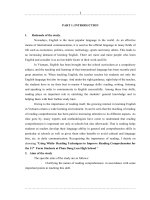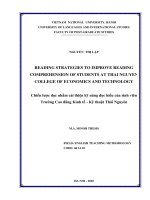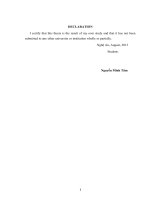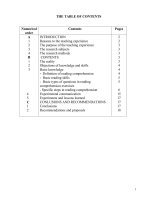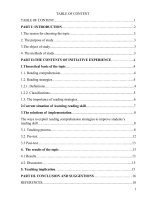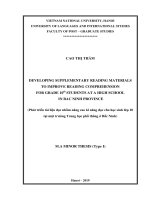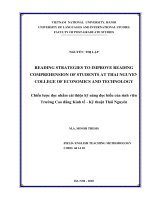Strategies to improve reading comprehension in ESL readers
Bạn đang xem bản rút gọn của tài liệu. Xem và tải ngay bản đầy đủ của tài liệu tại đây (143.64 KB, 12 trang )
CAN THO UNIVERSITY
SCHOOL OF SOCIAL SCIENCES AND HUMANITIES
DEPARMENT OF ENGLISH
GRADUATION PROJECT
ANNOTATED BIBLIOGRAPHY
STRATEGIES
TO IMPROVE READING COMPREHENSION
IN ESL READERS
Instructor:
Student’s name: Nguyễn Hồng Thu
Lưu Bích Ngọc, MA
Student code: 7116881
Class: XH11Z8A1
INTRODUCTION
1
The objective of learning English is to develop the ability to use English with various
skills, especially in listening and speaking skills, so that the learners are able to exchange
information effectively through both spoken and written channels in the future work and
social interactions. However, a good reading ability is also necessary for students to learn
English well. Reading is an important way to gain information in learning a foreign
language. It is also a basic skill for a foreign language learner. They learn reading to
solidify, extend basic knowledge and develop the lingual basic skills of listening, speaking,
reading and writing. So, fostering good reading ability is a leading task of learning English.
The key of reading is comprehension. Reading comprehension means extracting the
required information from the material as efficiently as possible. In order to get the
information the learners need from what they read, they must be able to read accurately and
quickly. A good reader is an accurate and fast reader. But which strategies to become a good
reader and how its effectiveness is. Starting from these issues above, I have chosen the
theme “Strategies to Improve Reading Comprehension Skills in ESL Readers” as my
project paper in which I have summarized 10 previous studies to give an overview about
this.
SUMMARIES
Glen berg, A.M. (2011). How reading comprehension is embodied and why that matters.
International Electronic Journal of Elementary Education, 4 (1), 5-18. Retrieved
August 26, 2014, from />According to Glen berg, in all cases, comprehension is the ability to take effective
action on the basis of affordability, related to the body, the physical world, personal
goals
and
cultural
norms. Reading
comprehension is embodied
much
like
comprehension of situations and comprehension of oral language. It is mentioned in
nine main points with clearly analysis of the author. The first main point is understanding
situations and language. Understanding is not just a cognitive state, but it is also the
case that in any particular situation, most actions are inappropriate. However, the
author argues further that the ability to act appropriately does not just reveal
2
understanding, but constitutes understanding. The second main point is reading
comprehension. The author considered learning to read. Instead of frequent and
immediate indexing of linguistic symbols to objects and experiences, when learning to
read indexing is slow, unreliable, and rarely practiced. The next is the moved by reading
intervention. This is a two-stage reading comprehension intervention designed for the
immediate readers. The moved by reading enhance reading comprehension dramatically;
so, we need implement the moved by reading one-on-one if there is necessary because
their long-term benefits and effective special to populations. However, the moved by
reading training have to transfer so that it can bring useful to user. At the end of this study,
the author investigated the suitable of moved by reading and reading in abstract domains.
That is, while moved by reading is suitable for children, reading in abstract domains is
suitable for adults. From these above arguments, the study indicated the reason why so few
readers understand centripetal force and other scientific concepts. When understanding the
text, the words and phrases are indexed to embodied experiences to create a simulation
of the content of the text because this simulation is in a format intimately related to
the body, it can be used to guide action. Through the way that language is embodied, the
learner can create successful educational interventions as the moved by reading.
Liao, G. (2011). On the development of reading ability. Theory and Practice in Language
Studies, 1. Retrieved August 26, 2014, from
/>In this brief study, Liao indicated that English reading skill is one of the important
language skills which readers have to master. Therefore, in order to improve readers’
reading ability, teachers should particularly focus on the development of effective reading
skill as using the context, using a dictionary, scanning skill, skimming skill, making
inferences and using the title, but it is more important than ever to have effective reading
skills. The context is known the sentence and paragraph in which a word occurs. To decide
the meaning of a word by using the context, readers have to use knowledge about
grammar, understand the authors' ideas and use the word analysis because they can
indicate the relationships among parts of the sentence and the paragraph and the meanings
3
of parts of words. If there are some cases in which you can find very few context clues to
use or there are too many new words to guess, the readers may rely on a dictionary
because a good dictionary provides some information about a word as spelling,
pronunciation, part of speech, definitions and something like that. In addition to role of a
good dictionary, the process of consulting a dictionary is a very helpful way to develop
scanning ability which involves moving your eyes quickly down the page seeking specific
words and phrases. The third effective reading skill is the skimming skill. This skill used to
quickly identify the main ideas of a text, done at a speed three to four times faster than
normal reading. People often skim when they have many materials to read in a limited
amount of time. The fourth skill in the whole skills above is making inferences. It is used
when the readers want to accurately understand an article and it has to make correctly. The
last one is using the title. It is sometimes useful for the readers to make quick decisions
based on only the title and try to understand it well. On the development of reading ability,
the readers also concern to reading habits, extensive reading, basic conditions for increased
reading rate and comprehension knowledge. There are different styles of reading for
different situations; so, the technique the readers choose will depend on the purpose for
reading. As long as the readers insist on using scientific skills, reading every day and
summing up continuously, the effective reading ability is not difficult to be achieved.
Kari, K. (2003). First language (L1) influence on second language (L2) reading: The
Role of Transfer. Retried September 2, 2014, from
/>This paper assesses the role of transfer on the influence of L1 to L2 reading and focus
on three aspects: nature of L1 and L2 reading processes, the influence of L1 on L2 reading
and transfer as a contributing factor in second language reading while studies of transfer
have mainly dealt with its effects on either speaking or writing, but the effects on reading
and listening have been neglected (Ringworm, 1992). In the first aspect, the author
indicates that foreign learners may transfer their first language knowledge or skills while
4
reading or writing in the second language. They use first language knowledge and various
strategies to facilitate their learning of target language. It is believed that overt transfer
may be transfer of forms, especially lexical items. It can also be phonological and
morphological forms, grammatical patterns or even procedures. In the next aspect, the
author demonstrates on the positive or negative role of reading in a second language. The
study of language transfer strategies may help us to better understand the positive
influence of the first language knowledge in foreign language reading comprehension
process. The review of the research literature displayed the following cases of transfer in
L2 reading context: phonological awareness/processing skills, orthographic strategies for
word recognition, vocabulary knowledge, comprehension and cognitive skills. In the last
aspect, the authors persuaded that in a second language learning context, it is vital to
investigate whether the learner is transferring L1 knowledge or skills and if so is it
facilitating or creating constraints on the way of successful reading. Based on the positive
or negative role of transfer, effective instructional methods can be designed for students of
different age groups. To sum up, the author indicates further and more extensive, there is a
correlation between L1 and L2 reading ability and L2 learners transfer prior linguistic and
cognitive skills from L1 to facilitate their reading ability in L2. Through investigating and
understanding reading transfer strategies, the learners will be better understand the
influence first language knowledge on reading and writing second language. This research
is also a stepping stone for the topic “Strategies to improve reading comprehension skill in
ESL readers”.
Akbar, Z. (2014). EFL Dictionary Users’ Skills and Their Reading Comprehension Skills:
A Mutual relationship. International Journal of Language Learning and Applied
Linguistics World, 6(3). Retrieved August 26, 2014, from
/>This research was done by Akbar about the mutual relationship of EFL Dictionary
Users’ skills and reading comprehension skills. At the beginning of the research, the author
indicated that the learner can determine the meaning of unfamiliar words and multiple
5
meaning words by using context clues, glossaries and dictionaries (Hamilton, 2012).
However, many types of dictionaries are necessary for learners work on the other language
development and a bilingual dictionary is often the first dictionary that a foreign language
learner encounters. With these above reasons, the author invited 35 first-year students in
Iran to take part in this study. By some instruments as the student's translation exercises,
the bilingual lists as well as the oral reading activities in the classroom, the author showed
the relationship between the student's dictionary problems and their reading
comprehension problems; that is whether or not dictionaries should be used, how their
reading problems originate from using bilingual dictionaries, how monolingual
dictionaries are used, how they develop and facilitate reading comprehension and how to
use the rich potentials inherent in them. To sum up, the finding of this paper will be of
great use to EFL learners, foreign language teachers and textbook designers. This research
also is of significance to textbook designers to embed dictionary skill studies along with
other reading comprehension skills and develop intimacy between the dictionary and the
user and reveals the significance of mastering reading skills in enhancing reading
comprehension. Through this research, we can recognize that using dictionary is also a
skill lead to effective reading comprehension.
Elemi, M. & Beady, S. (2010). The Effects of Pre-reading Activities on ESP Reading
Comprehension . Journal of Language Teaching and Research, 5. Retrieved August
26, 2014, from />In this study, the authors sought the effects of pre-reading activities on reading
comprehension of L2 learners of science and technology and divided into five parts.
According to the introduction part of the authors, the study will indicate the effects of prereading activities on comprehension of engineering students through the scores made by
subjects of the two experimental and control groups. In the literature review part, eight
sections about important of reading as one of the most important skills for educational and
professional success (Alderson, 1984), the most important activity in any class (Rivers,
1981); interactive view of reading and its relationship with ESP as interactive process
6
(Carrel, Devine & Esker 1988; Grabbed, 1991; Rumelhart & Ortony 1977), a simultaneous
perceptual and cognitive process (Rumelhart & Orton, 1977); general views on prereading activities as to active the student's knowledge of the subjects, to provide any
language preparation (Celce-Mucia, 1991), to provide a reader with the necessary
background to organize activity and to comprehend the material (Tudor, 1989); pictorial
context as an integral part of ESP courses, to visual support for the avoidance of problems
in the comprehension (Wilson, 1986); pre-questioning as to make students aware of the
way language is used to convey meaning; vocabulary pre-teaching as only one of the
possible ways in which the ESP teacher can assist in the activation of appropriate content
schemata so as to improve the student's comprehension of texts (Tudor, 1982; subtechnical vocabulary and ESP reading comprehension as were showed. It helps students
extract meaning from texts by using note-taking skill, solving problems set up in the texts
and similar methods. In the design part, these pre-reading activities were carried out five
sessions for experimental group, each activity lasted 10 minutes and was carried out
immediately before the reading task when participants in the control group received a
passage, they began reading task immediately after receiving their constructions for a full
account of practical employment of these pre-reading activities. The results of this study
paved the way for acceptance of the belief that giving related information of the text
through restoring to pre-reading activities can have large impact on reading
comprehension. So, we will come up with some guidelines for ESL teachers and syllabus
designers regarding reading pedagogy in the final section of the study.
Diaz, S. & Lag ado, J.C. (2013). Improving Reading Skills through Skimming and
Scanning Techniques at a Public School: Action Research. Retried August 28, 2014,
from
/>40/230
In this study, the authors show that skimming and scanning techniques play an
important role for improving reading skills with the theoretical framework of the study
7
based on the primary foundation of communicative approach, reading and reading
comprehension, skimming and scanning techniques. The authors use data from a survey at
a public school located in Pamplona Colombia and try to find out the role of skimming and
scanning techniques for improving reading skills through that survey. The data collection
instruments in the study consist of participant and non participant observations and semistructured interviews because it is able to extract real data from real situations. After that,
they analyze the data by several steps: get the data by understanding and re-checking the
data collected, read and reread the data several times in order to get familiar with them,
focus on the analysis by reviewing the purpose and the key research questions to be
answered, and keeping these in mind while we read once again the data, classify the
information, by identifying themes or patterns and organizing them into coherent
categories, identify patterns and connections within and between the categories, assess the
relevance of each category, capturing similarities between the categories and creating
super categories if necessary, give rich and detailed descriptions of the findings by
attaching significance and meaning to the analysis. Through collecting and analyzing data
from the survey, two authors indicated the techniques to change student's perceptions when
reading, motivation increases the effectiveness of skimming and scanning techniques,
student's inclination towards one of these techniques, students improvement through
reading comprehension techniques. This study seems to suggest that the participants
preferred to use the skimming technique to the scanning one. It was observed that the
students interacted more when working with the skimming technique, which did not
occur when
using the scanning one since some of the participants thought that the
scanning activities were more complex and longer, making them lose interest. However,
both skimming and scanning technologies are useful for improving reading comprehension
in ESL readers.
Rokni, S.A. & Niknaqsh, H.R. (2013). The Effect of Context Clues on EFL Learners’
Reading Comprehension. ELT voices-India, 3. Retrieved August 26, 2014, from
/>
8
In this short article, the authors designed to investigate the effects of context clues
on learners' reading comprehension. According to reading comprehension specialists,
reading is not actually a skill, but a process reading consists of many different skills.
Although reading comprehension is an essential part of exams, students may be not
instructed about reading skills which necessary to read some complicated texts in their
educational life. Therefore, the authors took this study to give a clearly strategy for
readers. That is the context clues and the effects that they may have on reading
comprehension in EFL learners. Clues play an important role in dealing with reading
comprehension and they are the important factors for comprehending a text and
learning new words. They are significant since there is a small chance of learning a new
word from a context. The context clues help explaining the meanings of difficult words by
giving an explanation in the preceding or very next sentence in simple language.
Moreover, guessing from the context is one of the most useful skills learners can acquire
and apply inside and outside classroom. The participants in this study were 60 EFL female
students at Goleta University in Groan, Iran during the academic year 2012. After
surveying, this study suggests the necessity of studying some issues such as context clues
involved in comprehending English texts. This investigation may help educators
understand some of the major causes behind reading habits of many Iranian and EFL
learners in private and of many readers in general.
Davoudi, M. (2005). Inference Generation Skill and Text Comprehension. The reading
matrix, 1. Retrieved August 26, 2014, from
/>In this article, Davoudi indicated that inferences is an essential part of reading
comprehension process. After that, the functions of inference, the factors affecting
inference making and some instructional techniques, strategies for the development of
inferential skill is provided. Firstly, some reading theorists and researchers accepted that
making inferences is necessary for reading comprehension, is a cognitive process used to
construct meaning. Inference in reading comprehension is also a constructive thinking
9
process with expanding knowledge of the readers through proposing evaluating competing
hypothesis about the meaning of the text in an attempt to progressively refine
understanding. Secondly, inference may serve different functions through a review of
research on inference generation. In the first generation of research, the inference has been
recognized as a crucial aspect of language. However, in the second generation of research,
it is focused on the balancing act that the readers must perform, both making inferences in
order to comprehend the text and having a limited attention or working memory sources
available to do so. The third generation of research is the development stage of inference
with the purpose is to integrate the online and offline aspects of reading. Thirdly, the
author indicates five factors affecting inference making, concerned to reader's background
knowledge, working memory capacity, reading ability, reader's goal and their interest.
Then, inference training is researched. It is not an inherently and applied to most children.
Finally, the strategies for the development of inferential skill of reading comprehension as
rebinding, questioning a default interpretation, shifting of focus, analyzing alternatives,
assigning an alternative case, confirming an immediate prior interpretation, confirming a
no immediate prior interpretation, assuming a default interpretation and transforming
information, withholding or reiterating information and emphasizing with the experiences
of others were provided to understand the text.
Abdullah, S. et al. (2012). Reading for pleasure as a means of improving reading
comprehension skills. Asian Social Science, 8. Retrieved August 26, 2014, from
/>In this short study, the authors proved the role of reading for pleasure in improving
reading comprehension skills through step-by-step as literature review, methodology,
results and discussion. The experiment group of this study was exposed to reading for
pleasure for five weeks while the other group was not. In the literature review, the author
group mentioned to three main points. The first one is reading comprehension and reading
strategies. Reading does not merely mean decoding the text into words as it involves
certain strategies and behaviors (Pressly, 2000). To comprehend a reading text, learners
10
should integrate the skills and apply certain strategies in doing so. The next one is reading
pleasure, they should have reading ability, positive exceptions of the activity and correct
book selection. The last one is reading motivation and reading interest. Reading motivation
refers to a person's personal goals, values and beliefs on reading topics, processes and
outcomes (Guthrie and Wigfield, 2000). It may come from internal and external factors.
Besides motivation, reading interest plays an important role in reading for pleasure, refers
to the selection of reading materials according to one's preference or interest. There are
two methodology chose in this experiment study, included selection of subjects and
procedure with total 48 students from two groups of Art and Design Faculty at UiTM
Perak. They spend three periods: at the beginning of the semester, at the reading project
progressed and at the end of the reading project. After these three periods, the control
group showed better improvement of comprehension skills in the post -test while the pretest scores results were nearly the same. The reason is that reading for pleasure would help
the readers to understand the text better and would pursue reading for pleasure. The
recognition of the value of these advantages suggests that teachers, policy makers and
curriculum designers should promote reading for pleasure and not perceive it as an activity
without merit or a separated skills.
CONCLUSION
To improve reading ability efficiently, the learner should develop some good reading
skills in the first place. Secondly, they must have good reading habits. Thirdly, they need to
know well about the questions of reading comprehension and enlarge your English
knowledge. Finally, there are different styles of reading for different situations. The
technique the learner choose will depend on the purpose of reading. For example, the
learner might be reading for enjoyment, information or to complete a task. If they are
exploring or reviewing, they might skim a document. If they are searching for information,
they might scan for a particular word. The learner need to adjust their reading speed and
technique depending on those purposes. As long as they insist on using scientific skills,
11
reading every day, and summing up continuously, the efficient reading ability is not
difficult to be achieved.
12
